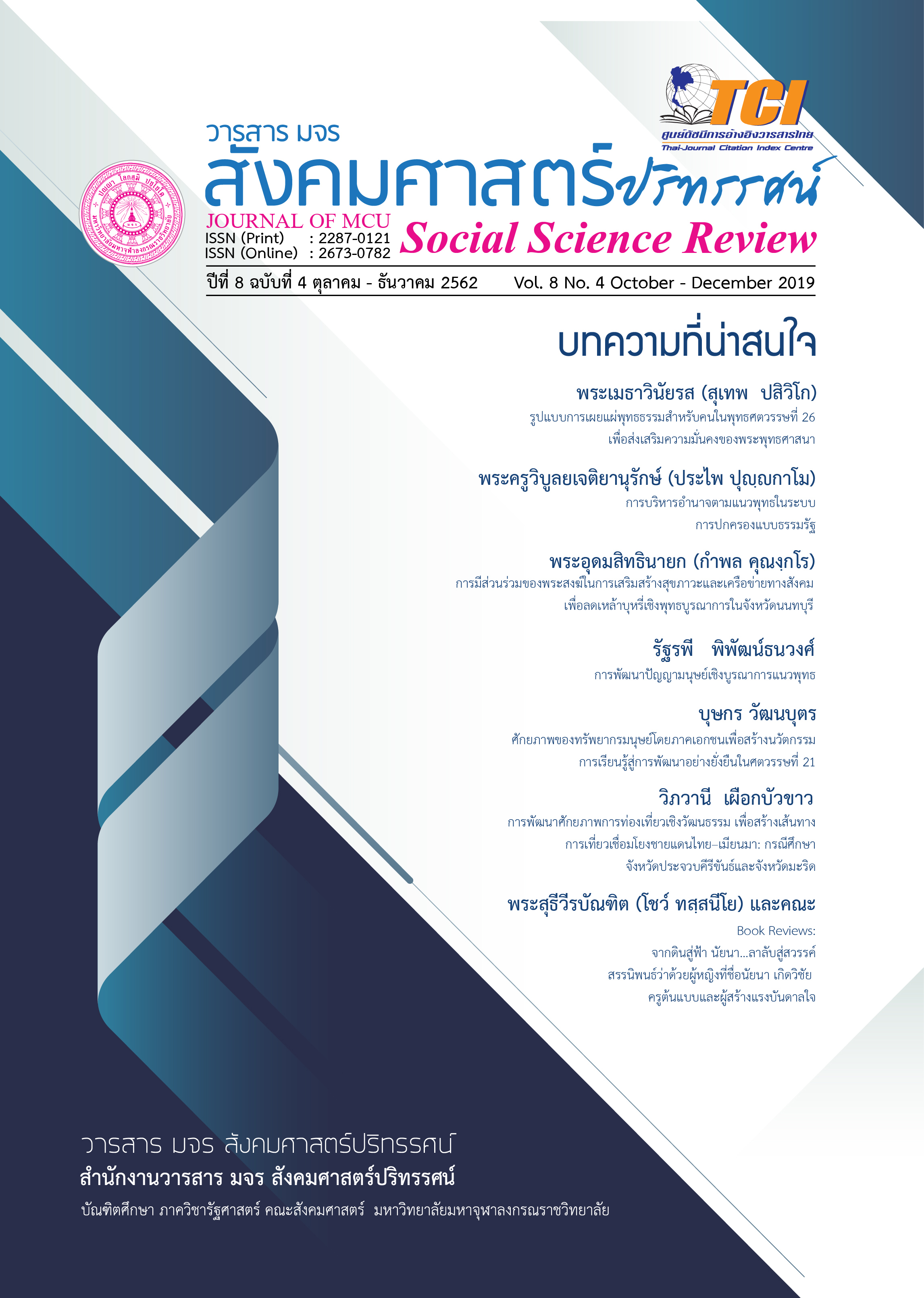รูปแบบการเผยแผ่พุทธธรรมสำหรับคนในพุทธศตวรรษที่ 26 เพื่อส่งเสริมความมั่นคงของพระพุทธศาสนา
คำสำคัญ:
รูปแบบ,, การเผยแผ่พุทธธรรม,, ความมั่นคงของพระพุทธศาสนาบทคัดย่อ
บทความนี้มีวัตถุประสงค์ดังนี้ 1) เพื่อศึกษาสภาพการเผยแผ่พุทธธรรมสาหรับคนในพุทธศตวรรษที่ 26 เพื่อส่งเสริมความมั่นคงของพระพุทธศาสนา และ 2) เพื่อพัฒนาและนาเสนอรูปแบบการเผยแผ่พุทธธรรมสาหรับคนในพุทธศตวรรษที่ 26 เพื่อส่งเสริมความมั่นคงของพระพุทธศาสนาเครื่องมือที่ใช้ในการวิจัย คือ แบบสอบถาม แบบสัมภาษณ์เชิงลึก และการสนทนากลุ่ม กลุ่มตัวอย่าง
ที่ใช้เพื่อการวิจัย ได้แก่ 1) พระสงฆ์นักเผยแผ่ จานวน 4,997 รูป กาหนดขนาดได้กลุ่มตัวอย่างได้จานวน 357 รูป และ 2) กลุ่มผู้ทรงคุณวุฒิ จานวน 30 รูป นาเสนอผลการวิจัยโดยการพรรณนาวิเคราะห์ข้อมูล ผลการวิจัย พบว่า1) สภาพการเผยแผ่พุทธธรรมสาหรับคนในพุทธศตวรรษที่ 26 เพื่อส่งเสริมความมั่นคงของพระพุทธศาสนา โดยภาพรวมอยู่ในระดับมาก เมื่อพิจารณาเป็นรายด้านทั้ง 6 ด้าน พบว่า ด้านพระสงฆ์อยู่ในระดับมากที่สุด ด้านวิธีการเผยแผ่ ด้านการใช้สื่อวัสดุอุปกรณ์ ด้านแผนงานและนโยบาย ด้านแผนงานและนโยบาย และด้านการสร้างเครือข่าย อยู่ในระดับมากทั้ง 4 ด้าน ส่วนด้านการส่งเสริมและสนับสนุนอยู่ในระดับปานกลาง
2) รูปแบบการเผยแผ่พุทธธรรมสาหรับคนในพุทธศตวรรษที่ 26 เพื่อส่งเสริมความมั่นคงของพระพุทธศาสนา มีดังนี้ 2.1) ด้านการสร้างเครือข่าย สร้างเครือข่ายเชิงรุกผ่านหน่วยงานของรัฐและองค์กรเอกชนเพื่อขับเคลื่อนการเผยแผ่พุทธธรรมโดยบูรณาการเชื่อมโยงกับสังคมและบุคคลต่าง ๆ ทั้งภายในประเทศและต่างประเทศเพื่อแลกเปลี่ยนเรียนรู้ร่วมกัน รวมทั้งมีการสร้างเครือข่าย
โดยการปฏิบัติการเผยแผ่เชิงรุกในพื้นที่ผ่านปราชญ์ชาวบ้าน ชุมชน และผู้นาชุมชนท้องถิ่น 2.2)ด้านวิธีการเผยแผ่ สร้างวิธีการและรูปแบบการเผยแผ่ด้วยกระบวนการที่หลากหลายเพื่อให้สอดคล้องกับความต้องการของสังคมพหุวัฒนธรรม สอดคล้องกับแนวคิด และเป้าหมายการเผยแผ่ตามหลักพุทธโอวาท ทั้งนี้เพื่อมุ่งเน้นให้พุทธศาสนิกชนมีความรู้ความเข้าใจในหลักธรรมคาสอน
อย่างถูกต้อง 2.3) ด้านการใช้สื่อวัสดุอุปกรณ์ สนับสนุนการนาเทคโนโลยีสารสนเทศมาใช้เป็นเครื่องมือในการเผยแผ่พุทธธรรมผ่านสื่อมวลชน IT และสื่อชุมชน เพื่อให้เข้าถึงประชาชนได้ง่ายทุกกลุ่มเป้าหมายโดยสร้างรูปแบบและนวัตกรรมการสื่อสารที่ทันสมัยเพื่อนามาประยุกต์ใช้เป็นสื่ออุปกรณ์ในการเผยแผ่พุทธธรรมผ่านสื่อสังคมออนไลน์ เช่น เฟสบุ๊ค ยูทูป เว็บไซต์ และไลน์ เป็นต้น
2.4) ด้านพระสงฆ์ ส่งเสริมและพัฒนาบุคลากรผู้เผยแผ่พุทธธรรมให้มีทักษะการเผยแผ่พุทธธรรมที่สอดคล้องกับการเรียนรู้ในศตวรรษที่ 21 โดยมุ่งเน้นพัฒนาคุณลักษณะและสมรรถนะขีดความสามารถ เพื่อเพิ่มประสิทธิภาพในการปฏิบัติงานด้านการเผยแผ่ให้ดียิ่งขึ้น 2.5) ด้านการส่งเสริมและสนับสนุน คณะสงฆ์และหน่วยงานภาครัฐสนับสนุนการเผยแผ่พุทธธรรมทั้งภายในประเทศและภายนอกประเทศอย่างเป็นรูปธรรม และส่งเสริมการสร้างธรรมทายาททุกระดับรวมทั้งส่งเสริมให้วัดมีศักยภาพเพื่อเป็นศูนย์การเรียนรู้และการปฏิบัติกิจกรรมการเผยแผ่ทางพระพุทธศาสนาเพื่อตอบสนองต่อความต้องการในการเรียนรู้ของประชาชน และ 2.6) ด้านแผนงานและนโยบาย พัฒนารูปแบบที่มุ่งเน้นการนานโยบายการเผยแผ่สู่การปฏิบัติที่เป็นรูปธรรมในทุก ๆด้าน โดยการมีส่วนร่วมของหน่วยงานที่เกี่ยวข้องทั้งภาครัฐและเอกชน รวมทั้งจัดทายุทธศาสตร์พระพุทธศาสนา 4.0 เพื่อสอดรับกับแผนยุทธศาสตร์ชาติ 20 ปีของรัฐบาล
เอกสารอ้างอิง
Phra Daonue Bootsitha. (2014). Formingand Managinga Networkof a Buddhist Community in Banpobthamnamsuk Community, Thungsalieng District,Sukhothai (Master of Thesis). National Institute of Development Administration.
Phrakrukhositsangpitak (Pravet Thathan). (2018). Strategies for Proactive Buddhism Propagation of Thai Sangha in Present Time (Doctor of Thesis). Graduate School : Mahachulalongkornrajavidyalaya University.
Phrakrukhositsangpitak (Pravet Thathan). (2017,September – December). Strategies for Proactive Buddhism Propagation of Thai Sangha in Present Time. Dhammathas Academic Journal, 17(3), 212-223.
Phramaha Sayan Nammuaeng. (1995). The Role of Monks on Teaching Buddhism : A Case Study of The Primary Schools in Bangkok (Doctor of Thesis). Graduate School : Mahachulalongkornrajavidyalaya. University.
Phramanit Jotidhammo (Accachart). (2009). A Study of Problems and Solutions for the Performance of the School Morality Teaching Monk in Si Sa Kat (Doctor of Thesis). Graduate School : Mahachulalongkornrajavidyalaya University.
Punnudda Noppanawan. (1990). A study of the Dhamma Communication Process of Thai Buddhist Institute (Master of Thesis). Graduate School: Chulalongkorn University.
School Morality Teaching Monk Project. (2006). Strategic Plan of School Morality Teaching Monk Project. Nakhon Prathom : Mahamakut Buddhist University.
Sukusar Nuntong. (2017). Quality Development of Academic Services Unit Management of Machulalongkornrajavidayalaya University (Doctor of Thesis). Graduate School : ahachulalongkornrajavidyalaya University.
Thawatchai Chinsongteerapanich. (2017). The Development of Competency in Propagation of the Temple Abbots.Thesis Graduate School : Mahachulalongkornrajavidyalaya University.
The Office of National Buddhism. (2010). The Performance of the School Morality Teaching Monks (Research Report). Nakhon Prathom : Printing of Religion Affairs Department.
ดาวน์โหลด
เผยแพร่แล้ว
รูปแบบการอ้างอิง
ฉบับ
ประเภทบทความ
สัญญาอนุญาต
ลิขสิทธิ์ (c) 2019 วารสาร มจร สังคมศาสตร์ปริทรรศน์

อนุญาตภายใต้เงื่อนไข Creative Commons Attribution-NonCommercial-NoDerivatives 4.0 International License.
เพื่อให้เป็นไปตามกฎหมายลิขสิทธิ์ ผู้นิพนธ์ทุกท่านต้องลงลายมือชื่อในแบบฟอร์มใบมอบลิขสิทธิ์บทความให้แก่วารสารฯ พร้อมกับบทความต้นฉบับที่ได้แก้ไขครั้งสุดท้าย นอกจากนี้ ผู้นิพนธ์ทุกท่านต้องยืนยันว่าบทความต้นฉบับที่ส่งมาตีพิมพ์นั้น ได้ส่งมาตีพิมพ์เฉพาะในวารสาร มจร สังคมศาสตร์ปริทรรศน์ เพียงแห่งเดียวเท่านั้น หากมีการใช้ภาพหรือตารางหรือเนื้อหาอื่นๆ ของผู้นิพนธ์อื่นที่ปรากฏในสิ่งตีพิมพ์อื่นมาแล้ว ผู้นิพนธ์ต้องขออนุญาตเจ้าของลิขสิทธิ์ก่อน พร้อมทั้งแสดงหนังสือที่ได้รับการยินยอมต่อบรรณาธิการ ก่อนที่บทความจะได้รับการตีพิมพ์ หากไม่เป็นไปตามข้อกำหนดเบื้องต้น ทางวารสารจะถอดบทความของท่านออกโดยไม่มีข้อยกเว้นใดๆ ทั้งสิ้น





